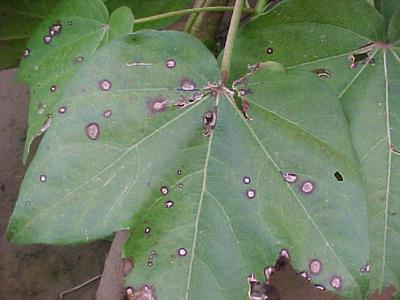Myrothecium Leaf Spot
Myrothecium roridum
Fungus
In a Nutshell
- Stem and crown rot.
- Light brown to black spots on leaves, near the margin.
- Center of lesions fall off - shot holes.
Can also be found in
Symptoms
Symptoms are characterized by stem and crown rot and the presence of brown, concentric spots on leaves. At high humidity, raised, black structures and white tufts may develop on the lesions, giving them a typical appearance. In horticultural crops, symptoms usually starts as a brown soft rot in the crown and on adjacent leaf petioles. As the lesions gradually progress along the stem, small white tufts appear on affected tissues. Small irregular brown to black spots appear on leaves. The spots gradually take a more circular shape, with a clearly defined middle concentric ring. Later on, the old lesions may coalesce and get covered with tiny white specks. As it dries up, the center of the lesions turn papery and whitish and may eventually fall off, leaving irregular shot holes in the leaves. The entire plant may collapse at later stages of the disease but fruits are rarely affected.
Recommendations

Organic Control
To this day no biological control method against Myrothecium Leaf Spot is known. Please contact us if you know of any methods to treat this fungus.

Chemical Control
Always consider an integrated approach with preventive measures, cultural practices and biological treatments if available. At the first observation of symptoms, spray mancozeb or copper oxychloride at 2kg/ha and repeat treatment two to three times at 15 days interval. If infection takes place late in the season, bear in mind that there is a pre-harvest interval to consider.
What caused it?
Symptoms are caused by the fungi Myrothecium roridum, a pathogen that periodically causes crown and stem rot on a series of economically important crops and ornamental plants. The disease is spread in several ways, for example through bad practices during transplanting, overhead irrigation, mechanical or insect wounding. The injured tissues become an entry point through which the fungus can infect the plant. Both the incidence of the disease and the gravity of symptoms increase in conditions of warm, wet weather and high humidity. Over-fertilisation can also cause lush foliage that can lead to more outbreaks of the disease.
Preventive Measures
- Find resistant varieties, if available.
- Avoid excessive fertilisation and use split applications during the season.
- Avoid injuries to plants during field work.
- Minimize periods of leaf wetness through careful timing of irrigation.
- Be sure to clean and then disinfect all tools after field work.
- Take care of produce during packaging as bad practices can result in wounding.
- Remove and destroy the infected plant residues.
- Avoid monocultures as it is the perfect way to propagate the disease.
- Apply lime to fields to get the best pH for your crops.



